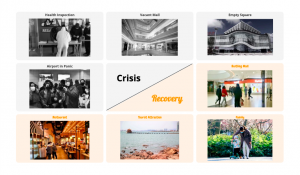Documentary title: Crisis and Recovery
Synopsis:
The outbreak of the coronavirus has become one of the central themes of people’s lives recently. It has brought great inconvenience to our daily activities. Fortunately, the spread of the virus has been effectively controlled in China and people’s daily routine is slowly returning to normal. This documentary illustrates the contrast of a city’s crisis and recovery by showing the images of the city in the middle and late stages of the epidemic. In fact, this relationship between the architectural environment and human activities shown by the images can demonstrate the transition from “place” to “space”. Hopefully we can appreciate this precious relationship and attach more emotions to the city or the “space” in which we live after recovering from this crisis.
Storyboard: 
Presentation:
Bibliography:
De Certeau, M. (1984). Spatial Stories. In The Practice of Everyday Life (pp. 115-130), translated by Steven Randall. Berkeley: University of California Press.
Fatima, M. & Neha, M. (2020). Coronavirus (COVID-19): Let’s prevent not panic. Retrieved from http://www.ayubmed.edu.pk/jamc/index.php/jamc/article/view/7564
Qingdaonews.com: http://www.qingdaonews.com
Name: Liu Fanyu
UID: 3035534397
Good concept of “crisis” and “recovery”, however, the storyboard currently needs to be more informed by in-depth research into the news so that you can get more perspectives to formulate your own.
Bibliography – why did you choose to cite “Journal of Ayub Medical College Abbottabad” in combination with “Qingdao News”? What was your intention of doing this? You could go further and emphasize the international / wide scope of this bibliography by adding more sources (e.g. mix of western / eastern news media and journals)